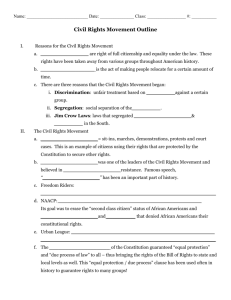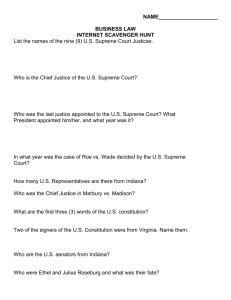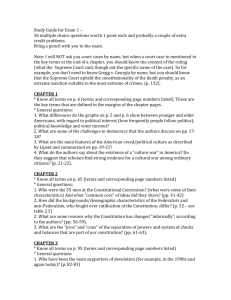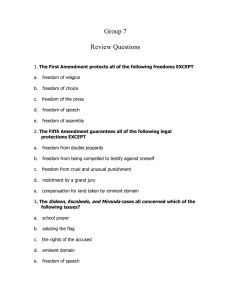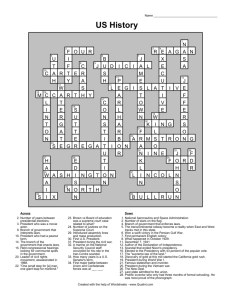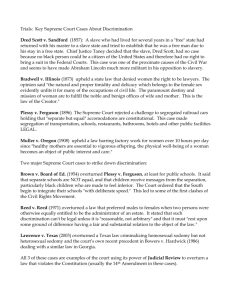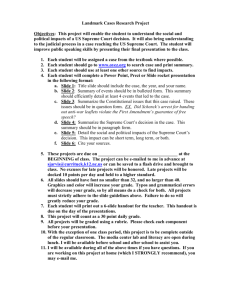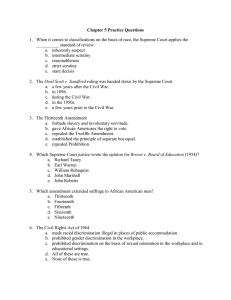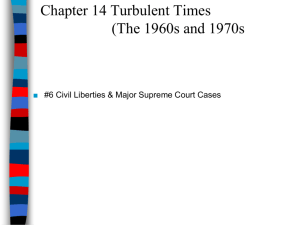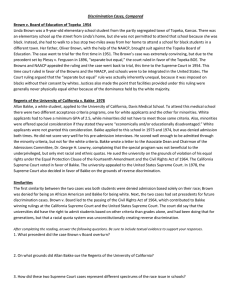Oakdale High School
advertisement
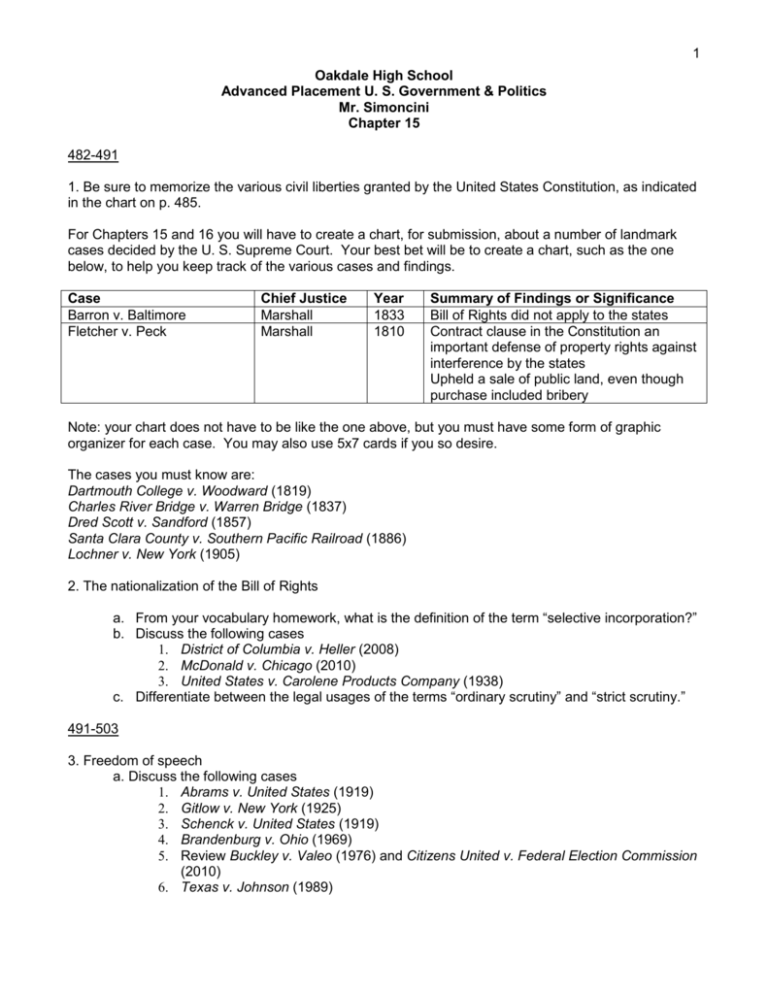
1 Oakdale High School Advanced Placement U. S. Government & Politics Mr. Simoncini Chapter 15 482-491 1. Be sure to memorize the various civil liberties granted by the United States Constitution, as indicated in the chart on p. 485. For Chapters 15 and 16 you will have to create a chart, for submission, about a number of landmark cases decided by the U. S. Supreme Court. Your best bet will be to create a chart, such as the one below, to help you keep track of the various cases and findings. Case Barron v. Baltimore Fletcher v. Peck Chief Justice Marshall Marshall Year 1833 1810 Summary of Findings or Significance Bill of Rights did not apply to the states Contract clause in the Constitution an important defense of property rights against interference by the states Upheld a sale of public land, even though purchase included bribery Note: your chart does not have to be like the one above, but you must have some form of graphic organizer for each case. You may also use 5x7 cards if you so desire. The cases you must know are: Dartmouth College v. Woodward (1819) Charles River Bridge v. Warren Bridge (1837) Dred Scott v. Sandford (1857) Santa Clara County v. Southern Pacific Railroad (1886) Lochner v. New York (1905) 2. The nationalization of the Bill of Rights a. From your vocabulary homework, what is the definition of the term “selective incorporation?” b. Discuss the following cases 1. District of Columbia v. Heller (2008) 2. McDonald v. Chicago (2010) 3. United States v. Carolene Products Company (1938) c. Differentiate between the legal usages of the terms “ordinary scrutiny” and “strict scrutiny.” 491-503 3. Freedom of speech a. Discuss the following cases 1. Abrams v. United States (1919) 2. Gitlow v. New York (1925) 3. Schenck v. United States (1919) 4. Brandenburg v. Ohio (1969) 5. Review Buckley v. Valeo (1976) and Citizens United v. Federal Election Commission (2010) 6. Texas v. Johnson (1989) 2 4. Freedom of the press a. Discuss the following cases 1. Near v. Minnesota (1931) 2. New York Times v. United States (1971) 3. New York Times v. Sullivan (1964) 4. Miller v. California (1973) 5. New York v. Ferber (1982) 5. Freedom of Religion and Free Exercise of Religion a. Minersville School District v. Gobitis (1940) b. West Virginia v. Barnette (1943) c. Employment Division v. Smith (1990) d. City of Boerne v. Flores (1997) 6. Establishment of Religion a. Lemon v. Kurtzman (1971) and the Lemon test b. McCreary County, Kentucky, et al. v. ACLU (2005) and Van Orden v. Perry (2005) c. Engel v. Vitale (1962) d. Lee v. Weisman (1992) and Santa Fe Independent School District v. Doe (2000) 7. Privacy a. Griswold v. Connecticut (1965) b. Roe v. Wade (1973) c. Bowers v. Hardwick (1986) d. Gonzales v. Oregon (2006) 503-514 8. Rights of the accused a. Mapp v. Ohio (1961) and the exclusionary rule b. Murray v. United States (1988) c. Wyoming v. Houghton (1999) d. Miranda v. Arizona (1966) e. Gideon v. Wainwright (1963) f. McCleskey v. Kemp (1987) 9. Discuss the highlights of the USA Patriot Act (2001) 3 Chapter 16: Civil Rights 518-533 1. As a review, what were the Reconstruction Amendments? What were the key provisions of each? 2. What was the significance of the Slaughterhouse Cases (1873)? 3. As a review, discuss Plessy v. Ferguson (1896) and Brown v. Board of Education of Topeka, KS (1957). 4. Discuss ways southern states circumvented the Fifteenth Amendment to the Constitution. 5. Discuss “de jure discrimination” and “de facto discrimination” as the terms pertain to the Civil Rights Movement. 6. Discuss key events and actions that led to the end of government-sponsored discrimination against racial minorities. In your discussion, include the concept of affirmative action and the United States Supreme Court’s decision in the Regents of the University of California v. Bakke (1978). 7. How has the U. S. Supreme Court tended to rule regarding affirmative action since its decision in the Bakke case? Cite specific examples. Be sure to discuss non-educational institution cases, such as Ricci v. DeStefano (2009). 534-544 8. Discuss the U. S. Supreme Court’s findings in Craig v. Boren (1976) and United States v. Virginia (1996). Has the issue of women’s rights followed the path of other American rights and liberties? 9. Discuss Title IX of the Civil Rights Act of 1964. What do you think were some of the negatives of that part of the U. S. Code? 10. How has the Supreme Court tended to rule on the topic of sexual harassment in the workplace? Discuss specific findings (cases). 11. Discuss some key provisions of the Age Discrimination in Employment Act of 1967. 12. How has the U. S. Supreme Court tended to find in cases pertaining to the rights of gay and Lesbian people? In your response discuss: Bowers v. Hardwick (1986), Romer v. Evans (1996) and Lawrence v. Texas (2003). 13. Discuss President Clinton’s “Don’t ask, don’t tell” policy. 14. What was the Defense of Marriage Act of 1996? How has the federal court system responded to that law in recent years?

